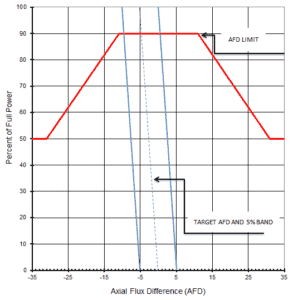Axial Offset Anomaly
 As was written, the axial offset – A/O (or AFD) and the QPTR are direct and continuous measures of the core’s global power distribution. A/O measures global axial power distribution, whereas QPTR measures global azimuthal power distribution. Staying within their limits and proper operation of the control rods should maintain acceptable peaking factors (FQ(z) and FΔH) on a continuous basis. The AFD and QPTR limits ensure that peaking factors (FQ(z) and FΔH) remain below their limiting values by preventing an undetected change in the gross axial and radial power distribution.
As was written, the axial offset – A/O (or AFD) and the QPTR are direct and continuous measures of the core’s global power distribution. A/O measures global axial power distribution, whereas QPTR measures global azimuthal power distribution. Staying within their limits and proper operation of the control rods should maintain acceptable peaking factors (FQ(z) and FΔH) on a continuous basis. The AFD and QPTR limits ensure that peaking factors (FQ(z) and FΔH) remain below their limiting values by preventing an undetected change in the gross axial and radial power distribution.
In past, some PWR-type nuclear power plants (with LiOH water chemistry) have experienced small radial and especially axial offset anomalies (AOA). That means, some PWRs have experienced a unexpected and gradual shift in the target flux difference (ΔItarget) towards more negative values – shift of power from top half to bottom half.
After extensive research, it was found that axial offset anomaly can be caused by crud buildup on high-power fuel assemblies, in which an increased subcooled nucleate boiling can occur. Therefore this phenomenon is also known as the crud induced power shift (CIPS). Since this subcooled nucleate boiling occurs in the upper part of the assembly, crud accumulation causes an accumulation of boron on the surface of the upper part of the assembly. Lithium borate is absorbed and concentrated in the crud layer, reducing the fission rate in the upper portion of the core. It must be noted, not all reactor cores have experianced the AOA, it is now known that AOA is caused by a combination of high crud level in the coolant, high boiling intensity in the core and is strongly dependent on reactor water chemistry. Note that, some reactor design use LiOH to control pH of the reactor coolant and some use KOH.
In result, during fuel cycle the neutron flux shifts from top half to bottom half and causes an increase in local peaking factors. Crud accumulation may also cause a reduction in available SDM (3-4 pcm/day). Near the end of cycle, excess burnup in the bottom of the core and reduced boron and lithium concentrations in the reactor coolant system cause the power distribution to shift back toward the upper portion of the core, partially restoring the burnup distribution.
Special Reference: Information Notice No. 97-85: Effects of Crud Buildup and Boron Deposition on Power Distribution and Shutdown Margin, US NRC, 12/1997.
We hope, this article, Axial Offset Anomaly – Crud Induced Power Shift, helps you. If so, give us a like in the sidebar. Main purpose of this website is to help the public to learn some interesting and important information about thermal engineering.